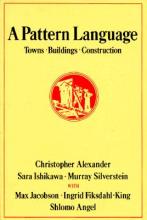A Pattern Language: Towns, Buildings, Constructions
by Christopher Alexander, Sara Ishikawa and Murray Silverstein
 This is honestly one of the most enlightening, perception-changing books I’ve ever read. Not only would I press it upon anyone thinking about building a house of their own, I’d also wholeheartedly recommend it to anyone studying any kind of design.
This is honestly one of the most enlightening, perception-changing books I’ve ever read. Not only would I press it upon anyone thinking about building a house of their own, I’d also wholeheartedly recommend it to anyone studying any kind of design.
What’s in the book
A Pattern Language is actually part two in a trilogy of books on how to design and build. It contains a description of how to use it in any building design process and then no less than 253 patterns, sorted into groups. Each pattern illuminates a common problem in cities, or a step in the design process, or an aspect of construction. In these patterns, the authors sum up each and every problem of construction, planning or design they’ve come across, succinctly and exactly, and then present a logical, very well thought out solution, the best they could come up with. I’ve read it through, and many of these were things I’d never even noticed or stopped to think about, and some I was dimly aware of but didn’t think to try and find a better solution to than what you usually get. So I got excited with every pattern I devoured: Another new and shining way of looking at things! Another change of view! It broadened and deepened my understanding of what a house is, how places work psychologically, what human needs are concerning their surroundings. I loved reading it.
Small caveat:
Well… what bothers me just a tiny little is their style of writing. They put in more commas than I’d use in German, and German usually has at least twice as many commas as English. It sounds a little old-fashioned, like an elderly uncle sitting down to explain something quite understandable and accessible to you in a rather roundabout and very elaborate way. Then again, this book is from the 1970s. What’s much worse is that every exemplary person in the book is male. Everybody is a he. Even children are always boys. This bugs me a lot, I feel completely disregarded. And reading about “a man and his wife” makes me wrinkle my nose in indignation. But as I said, this was written in the 1970s…
Why I keep raving about it
What makes this book such a good read to me is the thoroughness and consequence with which the authors question all the established ways of building and construction anything from a cottage to a whole big city. They just don’t stop at anything. Everything, everything gets looked at and questioned. It really is a very well thought out book. I’m working with it a lot these days – I’m going to mention it a lot in my next article (or maybe the one after that) which I intend to write as soon as I have a presentable version of our new floor plan(s).
- Log in to post comments